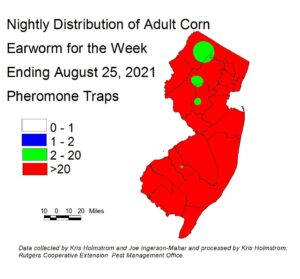Sweet Corn
European corn borer (ECB) moths are still appearing in several locations, but numbers remain very low, and feeding has only occasionally been reported. ECB population maps will resume if second flight catches rise to high enough numbers.
The highest nightly blacklight trap catches of ECB for the week ending 08/25/21 are as follows:
| Bellemeade 1 | Farmingdale 1 | Hillsborough 1 |
| Centerton 1 | Flanders 1 | Old Bridge 1 |
| Downer 1 | Green Creek 1 | South Branch 1 |
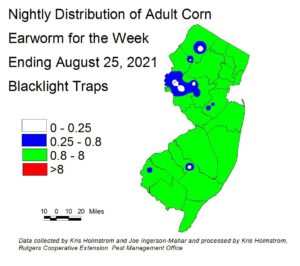 Corn earworm (CEW) moth captures from both trap types continue to increase!!. Blacklight and pheromone trap catches indicate that the late summer migration is underway. Both trap types throughout the state are in agreement as to spray schedules (see below). Check this publication weekly for CEW status. The number of pheromone traps deployed is much lower, resulting in much broader color bands on the map. It is also important to understand that pheromone traps are more sensitive than blacklight traps, and thresholds are adjusted to account for the higher catches typical of this trap type. Silking corn is at extreme risk of CEW infestation at this time. On the blacklight map (left), green areas represent a 3-4 day silk spray schedule. Blue and white areas on the blacklight map should be considered outliers, and disregarded at this time. On the pheromone map (below right), red represents a 3 day spray schedule. Green areas on the pheromone map should be disregarded at this time. Be sure to access information from this publication in the upcoming weeks to determine how frequently you should treat silking sweet corn to protect it from CEW infestation.
Corn earworm (CEW) moth captures from both trap types continue to increase!!. Blacklight and pheromone trap catches indicate that the late summer migration is underway. Both trap types throughout the state are in agreement as to spray schedules (see below). Check this publication weekly for CEW status. The number of pheromone traps deployed is much lower, resulting in much broader color bands on the map. It is also important to understand that pheromone traps are more sensitive than blacklight traps, and thresholds are adjusted to account for the higher catches typical of this trap type. Silking corn is at extreme risk of CEW infestation at this time. On the blacklight map (left), green areas represent a 3-4 day silk spray schedule. Blue and white areas on the blacklight map should be considered outliers, and disregarded at this time. On the pheromone map (below right), red represents a 3 day spray schedule. Green areas on the pheromone map should be disregarded at this time. Be sure to access information from this publication in the upcoming weeks to determine how frequently you should treat silking sweet corn to protect it from CEW infestation.
The highest nightly blacklight trap catches of CEW for the week ending 08/25/21 are as follows:
| Allamuchy 8 | Cinnaminson 4 | Downer 3 |
| Georgetown 7 | Denville 4 | Flanders 3 |
| Green Creek 5 | Pennington 4 | Medford 3 |
| Jones Island 5 | Centerton 3 | Princeton 3 |
The highest nightly pheromone trap catches of CEW for the week ending 08/25/21 are as follows:
| Jones Island 144 | Pedricktown 70 | East Vineland 45 |
| Tabernacle 90 | Eldora 68 | Woodstown 43 |
| Green Creek 89 | Elm 58 | Crosswicks 42 |
| Allamuchy 81 | Matawan 48 | Califon 31 |
Silking Spray Schedules*:
South – 3 days
Central – 3 days
North – 3 days
*These recommendations are based on regional catches. Adhere to tighter spray schedules if indicated by local trap catches. Synthetic pyrethroids alone should NOT be used for corn earworm (CEW) protection on silking corn, or for fall armyworm (FAW) management at any stage. Control with these materials is very inconsistent. Utilize materials in IRAC groups 5 and 28, or combination products that include IRAC group 28 for best control. See the Sweet Corn section of the 2020-21 Commercial Vegetable Production Guide for selections.
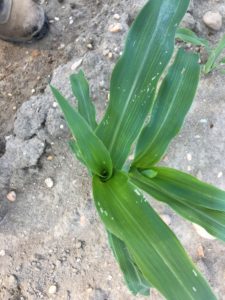
 Fall armyworm (FAW) larval infestations are ongoing, particularly in coastal areas. While not extreme, threshold levels are being detected regularly in Cape May, Monmouth and Ocean counties, with re-infestation happening quickly. Infestations in other parts of the state are more sporadic, but can still be economically important. Injury from newly hatched larvae shows up as “window panes” or areas where leaf tissue has been eaten down the the lower epidermis (see photo at far left). This injury leads down into the whorl. As larvae gain size, they begin to consume leaf tissue in its’ entirety, creating ragged holes and lots of droppings (see photo at near left). FAW can be tough to manage because it is resistant to synthetic pyrethroid insecticides (IRAC 3A) and because larvae are often covered by their own droppings, making contact with the insecticide more difficult. Treat when 12% or more plants exhibit FAW injury alone, or in combination with ECB injury. As a rule, insecticides that are most effective on CEW will also adequately control FAW.
Fall armyworm (FAW) larval infestations are ongoing, particularly in coastal areas. While not extreme, threshold levels are being detected regularly in Cape May, Monmouth and Ocean counties, with re-infestation happening quickly. Infestations in other parts of the state are more sporadic, but can still be economically important. Injury from newly hatched larvae shows up as “window panes” or areas where leaf tissue has been eaten down the the lower epidermis (see photo at far left). This injury leads down into the whorl. As larvae gain size, they begin to consume leaf tissue in its’ entirety, creating ragged holes and lots of droppings (see photo at near left). FAW can be tough to manage because it is resistant to synthetic pyrethroid insecticides (IRAC 3A) and because larvae are often covered by their own droppings, making contact with the insecticide more difficult. Treat when 12% or more plants exhibit FAW injury alone, or in combination with ECB injury. As a rule, insecticides that are most effective on CEW will also adequately control FAW.
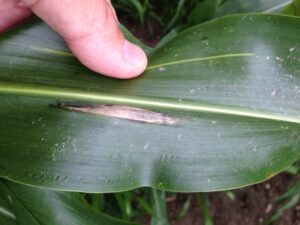 Northern corn leaf blight (NCLB) is now appearing in more fields throughout northern NJ (see photo at left). This fungal disease can increase in severity with longer dew periods that typically occur in August-September. Storm systems forecast for late this week will increase occurrence and spread of this disease. Lesions may form on husks, making them unsightly. Heavy infections can result in reduced ear size. When scouting, note the presence of these lesions, particularly if they first appear in whorl stage sweet corn. Fungicides may be required to limit infections. Useful materials include fungicides in FRAC codes 3,7 and 11, and may be found in the Sweet Corn section of the 2020-21 Commercial Vegetable Recommendations.
Northern corn leaf blight (NCLB) is now appearing in more fields throughout northern NJ (see photo at left). This fungal disease can increase in severity with longer dew periods that typically occur in August-September. Storm systems forecast for late this week will increase occurrence and spread of this disease. Lesions may form on husks, making them unsightly. Heavy infections can result in reduced ear size. When scouting, note the presence of these lesions, particularly if they first appear in whorl stage sweet corn. Fungicides may be required to limit infections. Useful materials include fungicides in FRAC codes 3,7 and 11, and may be found in the Sweet Corn section of the 2020-21 Commercial Vegetable Recommendations.
Cole Crops
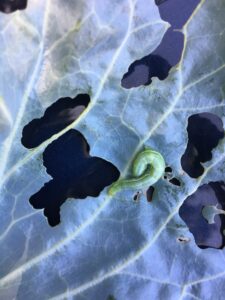 Fall plantings of cole crops are well underway at this time, and are frequently infested by imported cabbageworm (ICW) and diamondback moth (DBM) larvae. At this time, cabbage looper (CL-photo at left) and cross striped cabbage worm (CSCW-photo at right) are also causing
Fall plantings of cole crops are well underway at this time, and are frequently infested by imported cabbageworm (ICW) and diamondback moth (DBM) larvae. At this time, cabbage looper (CL-photo at left) and cross striped cabbage worm (CSCW-photo at right) are also causing injury to these crops.
injury to these crops.
Check 5 consecutive plants each in 10 random locations throughout the planting. Consider treating if caterpillars are found on 10% or more plants that are in the 0-9 true leaf stage. From 9-leaf to the early head stage (in broccoli, cauliflower, and cabbage) infestations up to 20% may be tolerated. Once heads begin to form, a 5% threshold should be observed to protect the marketable portion of the plant. For leafy greens such as collards and kale, 10% plants infested is the threshold throughout.
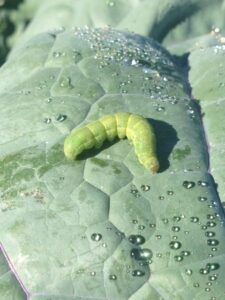 Some populations of DBM are resistant to carbamate and synthetic pyrethroid insecticides. The lack of DBM control with these insecticides has been noted in NJ previously. It is important to distinguish between common cole crop pests for this reason. DBM larvae grow to a length of approximately 0.5”, and taper toward both ends (see photo at right). These caterpillars thrash violently when disturbed. Newer chemistries that specifically target caterpillar pests are effective against DBM as well as all other caterpillar pests of cole crops, including beet armyworm (BAW-see photo at left), another species with exhibiting pyrethroid resistance. These materials include (active ingredient – trade name (IRAC* code)):
Some populations of DBM are resistant to carbamate and synthetic pyrethroid insecticides. The lack of DBM control with these insecticides has been noted in NJ previously. It is important to distinguish between common cole crop pests for this reason. DBM larvae grow to a length of approximately 0.5”, and taper toward both ends (see photo at right). These caterpillars thrash violently when disturbed. Newer chemistries that specifically target caterpillar pests are effective against DBM as well as all other caterpillar pests of cole crops, including beet armyworm (BAW-see photo at left), another species with exhibiting pyrethroid resistance. These materials include (active ingredient – trade name (IRAC* code)):
Spinosad/Spinetoram – Entrust(OMRI)/ Radiant (5)
Chlorantraniliprole – Coragen (28)
Cyantraniliprole – Exirel (28)
Peppers
Pepper weevil – Traps are deployed, and we have still captured no weevils in pheromone traps. We are not aware of any fields having infestations. We normally find the most infestations in August. That we haven’t trapped any weevils is a good thing. A new fact sheet is now available for anyone interested in monitoring for pepper weevils on their own: FS1330: Monitoring and Management of Pepper Weevil in New Jersey (Rutgers NJAES).
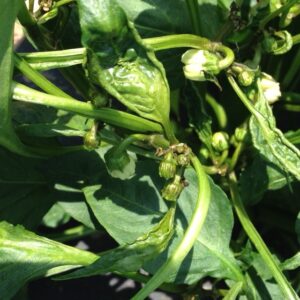
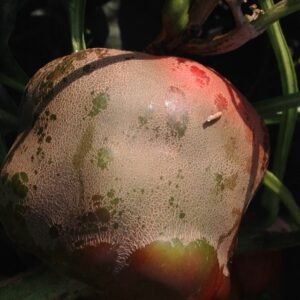 Recently, infestations of cyclamen mite have been discovered in a few pepper plantings. This microscopic mite’s presence in peppers is detected by the dramatic foliar distortion (photo at far left) it causes near growing terminals in addition to russeting that results from mites feeding on very young fruit (photo at near left). These infestations tend to be more common late in the summer. In field spread is slow, but delays in treatment result in greater numbers of damaged fruit on affected plants. Miticides recommended for spider mite control also manage cyclamen mite. Resumption of normal growth is a sign that the infestation has been controlled.
Recently, infestations of cyclamen mite have been discovered in a few pepper plantings. This microscopic mite’s presence in peppers is detected by the dramatic foliar distortion (photo at far left) it causes near growing terminals in addition to russeting that results from mites feeding on very young fruit (photo at near left). These infestations tend to be more common late in the summer. In field spread is slow, but delays in treatment result in greater numbers of damaged fruit on affected plants. Miticides recommended for spider mite control also manage cyclamen mite. Resumption of normal growth is a sign that the infestation has been controlled.
Beet armyworm (BAW) captures remain steady at low levels in southern NJ pheromone traps. This pest can attack peppers, and growers and scouts should check for the presence of heavily damaged leaves near terminal growth on pepper plants. BAW larvae will be found in the area of damage. As yet, no injury has been reported.
The highest nightly pheromone trap catches of BAW for the week ending 08/25/21 are as follows:
| Cedarville 2 | Hammonton 2 |
| Folsom 2 | Woodstown 2 |
Pumpkins and Winter Squash
Cucurbit downy mildew (CDM) is active on cucumbers in all parts of the state. As yet, other cucurbits, including pumpkins, butternut squash, acorn squash and watermelons have been unaffected. For regional information on this important disease, see the Cucurbit Downy Mildew Forecast webpage: http://cdm.ipmpipe.org/. This forecast has NJ at moderate risk of further infection as a result of transport events through Tuesday 8/24. As of Tuesday 8/24, no CDM infections on pumpkins or winter squash have been reported from our state. It is advisable that all growers treat cucumbers preventively for CDM. 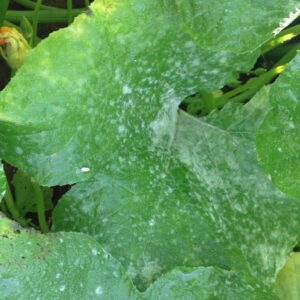
Pumpkin fields in the scouting program have all exceeded powdery mildew (PM) thresholds (2 lesions/100 older leaves), initiating the PM spray program. Lesions formed by this disease are shown in the photo (right). For a list of effective materials and fungicide rotations, see the Pumpkin/Winter Squash section of the 2020-21 Commercial Veg. Recs.
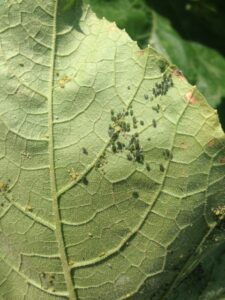 Melon aphid (see photo at left) populations may be present in pumpkin and winter squash fields. This aphid builds to heavy populations
Melon aphid (see photo at left) populations may be present in pumpkin and winter squash fields. This aphid builds to heavy populations 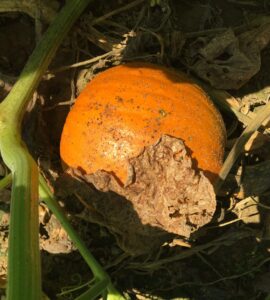 that result in the deposition of sticky droppings on the surface of fruit (see photo at right). If melon aphids appear in more than one sample site in a 10 site sample, consider treating to minimize the appearance of droppings. Insecticides effective at managing this pest are found in the Pumpkin and Winter Squash section of the Commercial Vegetable Production Recommendations.
that result in the deposition of sticky droppings on the surface of fruit (see photo at right). If melon aphids appear in more than one sample site in a 10 site sample, consider treating to minimize the appearance of droppings. Insecticides effective at managing this pest are found in the Pumpkin and Winter Squash section of the Commercial Vegetable Production Recommendations.
Brown marmorated stink bug (BMSB)
BMSB blacklight trap catches have decreased over the past week, and no map will appear in this addition.
